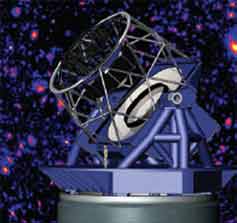

Wednesday – March 8, 2006
SLAC Today is
available online at:
http://today.slac.stanford.edu/a/2006/03-08.htm
In this issue:
Dark Matter, Say Cheese: LSST Director's Review this Week
What is LSST?
Cherrill Spencer: Promoting Awareness
Computing Announcement: Phishing in Our Pond
 |
 |
|
Wednesday – March 8, 2006 |

The Large Synoptic Survey Telescope (LSST) Dark Matter, Say Cheese:
|
||||||||||||||||||||||||||
|
|
||||||||||||||||||||||||||
 Cherrill Spencer: Promoting AwarenessNo matter how overwhelming her workload, Cherrill Spencer always makes the time to address women’s issues at SLAC. Spencer is the longest standing planning member of WIS, the Women’s Interchange at SLAC. “I have been a feminist for 37 years,” she said. “I believe women deserve the opportunity to become leaders without artificial barriers blocking them.” 
Although society has made great strides toward gender equality over the past three decades, Spencer said that hurdles remain. “They are more subtle now,” she said. “Now unspoken attitudes are the biggest obstacle.” As a doctoral candidate in elementary particle physics at Oxford University, Spencer was the only woman in the department. Feeling isolated, she joined a women’s support group—then called a women’s consciousness raising group—which helped women discuss the problems of working in a traditionally male endeavor. In the years to come, whether she was living in Switzerland, Italy or the Bay Area, support groups became a necessity in Spencer’s life. “I looked for three things every time I moved to a new place,” she said. “A place to live, a car and a women’s support group.” In early 1991, she saw a notice inviting people at SLAC to a meeting on women’s issues. There she found a group of women establishing WIS, a forum for discussing women’s issues open to everyone. But they needed help. “I must have put my hand up,” Spencer said, “because I have been on the planning committee every since.” In addition to her formal role as a magnet engineer at SLAC, Spencer volunteers with other members of the WIS planning committee to organize monthly seminars. Over the years these talks have encompassed nutrition, money management, sexual harassment and technical topics. Today, WIS will celebrate International Women's Day with refreshments from noon to 1 p.m. in building 214's Fuji Conference Room. The time will also be used to plan future WIS activities. |
Phishing in Our PondOn Monday of this week about 900 e-mails were sent to SLAC. The return address was service@sfcu.org. It claimed to be "A Warning From Stanford Federal Credit Union." This is a phishing e-mail. 
There were several ways to determine that this was a phony e-mail. The phishers failed to create the correct headers to make the e-mail display as HTML, causing the e-mail to show as plain text instead. This made it easy for the recipients to see that the URL in the e-mail was not directed to an official SFCU web site. Additionally, while the phishers spelled "Federal" correct in the subject line, they repeatedly spelled it as "Fedarl" in the body. Especially curious recipients could have expanded the headers to see that the message didn't come from SFCU e-mail servers. Instead, the messages came from e-mail servers all over the world: U.S., Taiwan, Korea... These servers have likely been compromised by viruses which leave them open for spammers and phishers to use. There are several lessons to take from this experience. Reading e-mails in plain text exposes the tricks which phishers and virus writers don't want us to see. Seeing that the URL wasn't a Stanford URL tipped most people off. If you want to see what the e-mail would have looked like in HTML please view this page. It is possible to change your e-mail client to display all e-mails as plain text. Instructions for doing so are available online. If you chose to display all e-mails as plain text, SLAC Today will also appear as plain text. To accept HTML in individual e-mails (such as SLAC Today), please read these instructions. Another way to determine if an important-looking e-mail is actually spam is to check for typos. If you receive an e-mail with obvious typos, you should expand the headers to see where it really came from. Instructions for expanding headers. The next phishing e-mail you receive will not be so obvious. Please be careful when opening unknown e-mail. View an FTC website that explains how to respond to phishing... |
Events (see all | submit)
Announcements
|
||||||||||||||||||||||||
| | ||||||||||||||||||||||||||
What's Cookin' ' at the Linear Cafe (see weekly menu)
|
||||||||||||||||||||||||||
|
|
||||||||||||||||||||||||||
 <%
Response.AddHeader "Last-modified", getArticleDate()
'Response.AddHeader "Last-modified","Mon, 01 Sep 1997 01:03:33 GMT"
'Monday, December 06, 2010
%>
<%
Response.AddHeader "Last-modified", getArticleDate()
'Response.AddHeader "Last-modified","Mon, 01 Sep 1997 01:03:33 GMT"
'Monday, December 06, 2010
%>View online at http://today.slac.stanford.edu/. |
||||||||||||||||||||||||||